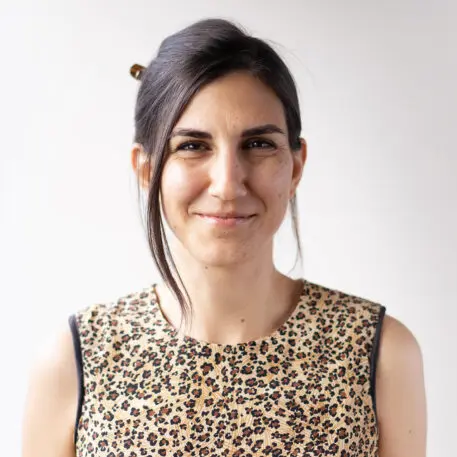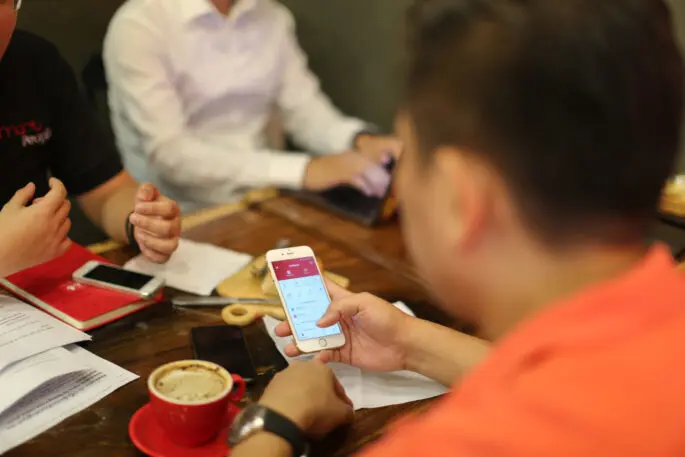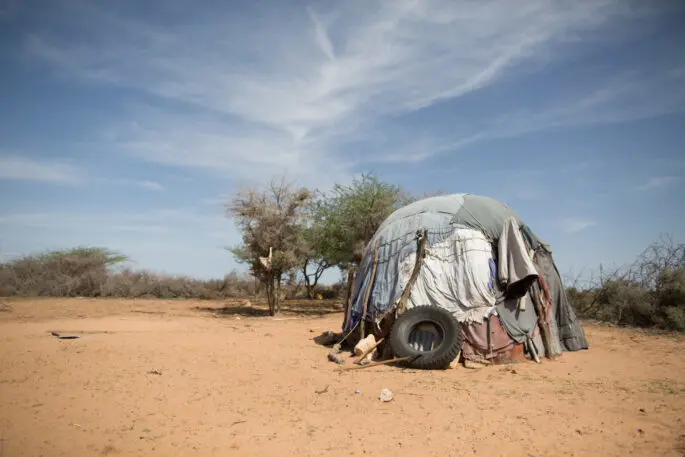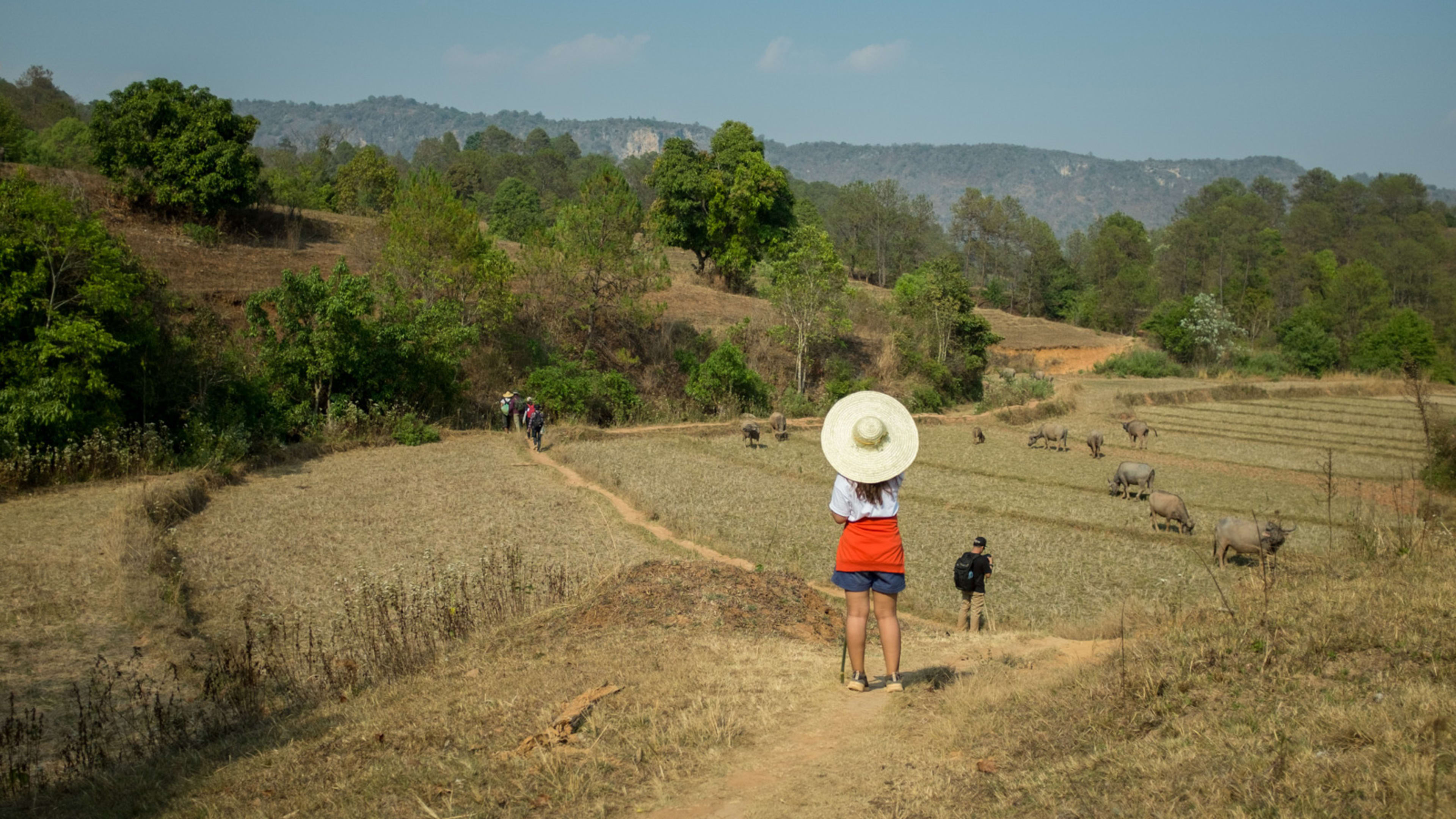Lauren Serota is a design consultant and the former head of service design for Yoma Bank in Myanmar. She spoke to Doreen Lorenzo for Designing Women, a series of interviews with brilliant women in the design industry.
Doreen Lorenzo: What was the role of design at Yoma Bank?
Lauren Serota: One of the biggest challenges I’ve had throughout my career is with the word “design.” At Yoma I was fortunate to get to define the word, and not worry about preconceived notions. We drove what I would call design-attributed activities: scenario-based creative thinking, customer-centricity, prototyping, and rapidly piloting in market. These activities are at the core of the design process, and are truly called upon in a rapidly changing environment like the Myanmar financial sector. The team at Yoma Bank blends product, marketing, ops, business intelligence, and design, and so design straddles being an individual contributing role (through activities like UI design) and more of a facilitative one, helping people cope with change and providing tools to guide them.

LS: The pandemic delayed consulting projects and fieldwork, and the pause was welcome as it allowed me to spend part of the year focused on other things. I started a small cosmetics business in 2015 with a single product that people love, and I was able to spend time in the spring fixing a few operational and financial pieces that had been on the back burner. I was able to reconnect with family and friends in Europe and the United States in a way that was difficult to do when I was heads-down in Yangon. I spent a lot of time with my dad in his garden, and with my mom, who is a retired nurse and had been reenlisted to work in contact tracing and testing for the pandemic. Watching the variety in pandemic response across Hawaii, Yangon, Amsterdam, and Austin was fascinating. I kept a close eye on what was happening with friends’ businesses—the backflips they were doing to stay in business and keep their teams working despite local rules changing (sometimes weekly), and how they balanced what needed to happen to stay afloat with exposure risks for customers and team members.
DL: So what have you learned in this period? What new practices will you take with you as we reenter the world as we know it?
LS: For businesses, it has never been more apparent that a combination of clear, shared values and organizational nimbleness are critical for survival. In terms of design and research practices, I just wrapped a consulting project with a team distributed across three continents. Fortunately, the topic lent itself to remote interviews, and we were able to cover more markets than we would have if we were doing in-context fieldwork. Four or five years ago, it was like pulling teeth to get people to meet virtually. No one knew how to relate or how to hold each other accountable. Some of the tools didn’t exist, while other tools did but were clumsy and spotty. A lot of those barriers are gone now.

DL: How have your research methods evolved?
LS: For remote work, there are now great virtual research tools for things like remote sensing, diary-keeping, and remote recording. As a result, I think there is a huge opportunity to bring a little more research into people’s day-to-day lives, and let them tell the story that they want. But I don’t think that’s ever going to replace being in person with people for specific topics that are really context-rich.
More broadly, my approach has evolved significantly over the past few years. Most projects involve a combination of secondary research, in-depth fieldwork, and quantitative data analysis. It’s become increasingly important to have a strong foundation of knowledge going into fieldwork, both in the topic and in what the client already knows (or thinks they know) via their data. I’ve therefore focused on building teams with embedded thought diversity and subject-matter knowledge, which means there are rarely more than one to two designers on the team (myself included). This requires more involvement, and it flies in the face of a lot of “design-centric” approaches, however it is the responsible thing to do.
DL: What do you think is the best design research tool?
LS: The question—or asking the right question. Ineffectively framing a problem is the quickest path to wasted work. What problem are you trying to solve? What do you want to learn? Good researchers know that sometimes solving a client’s problem may not be about talking to customers, but looking internally at the organization’s own competencies.
Steve Portigal’s Twitter is this wonderful encyclopedia of research gone wrong. He’s a good critic of the mistakes that organizations make when they survey—where and how they introduce bias, either consciously or not. I’m optimistic that the industry is mature enough that teams can broadly identify good versus bad UX research, however we still have a ways to go in expanding design research as a mature practice beyond yielding recommendations for product improvements.
DL: What do you think organizations are still getting wrong about design research?
LS: Neglecting to make a foundational commitment to diversity—this includes gender, racial, ethnic, cultural, and economic diversity, as well as diversity of thought. A diverse team operating in a healthy workplace can force an entire organization to reconcile the biases brought into research, decision-making, and business design. It’s relatively easy to hire researchers and designers who have a relevant background in UX, research or a specific business area. Hiring for experience in a particular field can compound the bias a team—including a bias toward those in privileged backgrounds. Just like quantitative analysis is limited by the kind of data an organization chooses to collect, all other activities of a team can be limited by the scope of their experience and the questions they know to ask.
Another common mistake is using design research (or any research) alone to try to prove something right or wrong. Any organization that believes research or consumer insights are a means to validate difficult decisions—rather than a practice to inform how their business works and evolves—is going to have a really difficult time. Design research provides data points. Analysis of existing customers and behavioral data provides data points. Market trends provide data points. Using any one source of data as gospel is naïve, as is separating these pieces of knowledge-building out into separate functions. Design needs to be nurtured within an organization. It’s not just listening to people, but paying attention to the data you’re collecting, how you’re using it, and the story it’s telling you. Numbers and powerful stories can create equally dangerous levels of confidence.
DL: Did you go to design school?
LS: I did. A supportive family and fantastic art and humanities teachers in high school helped me realize that I wanted to make things. I studied industrial design at the Savannah College of Art and Design, when there was a nascent interaction design program. Through this, I was exposed to what we would now call UX and interaction design. I realized I was better at the beginning part of the design process, and did not always have the craft and patience required to work in CAD, or with injection molding. I was better at learning from users of a product, understanding the commercial goals of a business, and the manufacturing and regulatory constraints, and turning them into something that worked for all. I graduated in 2006 right before the recession, and one of the biggest services I did myself was not thinking I needed to land a job as a junior designer at Philips or Target, or that I needed to be on this traditional trajectory of an industrial design grad.
DL: Which projects throughout your career really touched you and made a difference in your life?
LS: As a junior design researcher at Lextant in Columbus, Ohio, I worked on a project for a home air control device (a thermostat). We had done a huge research project to understand how people relate to different products in their home, and I was able to translate those insights into the interface and some of the hardware for this particular product. That was when I first realized that I should work in this “translation” space, which we would now call product strategy. I wanted more opportunities like that, so I started working at frog shortly after. At frog I was often put on projects with just a strategist, a technologist, and maybe one other designer. We would have to figure out something in three weeks’ time. It would be a rush. I still reflect on some of those as rendering my best work as a designer. Those experiences really helped me sharpen my skills and figure out what I’m good at and where I can add value.
Also at frog, I worked with UNICEF in Zambia to improve an SMS system that rapidly provides test results to parents whose newborns might have been HIV-exposed. My unexpected takeaway from this program was personal observations of the role of aid in impact and in development. I struggled with the political situation, with how that project was set up and how funds were being used, that there wasn’t a cycle of value including the end recipients of the product or service, and how many things were in the way of getting stuff done. I’d seen that work better in commercial models, so that got me thinking: Does impact really need to be non-profit? What is the long-term impact on markets and customers if it is? Or are there things that are in the middle? I don’t think there’s a clear answer, but that project shaped my perspective on where I wanted to make an impact.
When I went out on my own, I wasn’t really on my own. On most projects, a small, senior team defined everything–the scope, the deliverables, the approach. I saw in this work and in the people I worked with a completely different way of making a path, and models of the type of leader I wanted to be.

LS: It can be terrifying to go into a new place, especially a place like Somalia or Saudi Arabia—but they’re not terrifying places. I just needed to understand what I was getting into, how people were going to perceive me, and what behaviors I needed to adopt. To feel emotionally and logistically prepared before going into a new environment, whether it was Australia or Zambia or the Emirates, I learned as much as I could, established relationships with people who lived there or knew the place well, and tried to understand the similarities and differences between myself and the people I would find when I landed. There is typically more similarity than difference.
DL: What have you learned from meeting so many different kinds of people?
LS: What stands out is the overwhelming hope that everyone—from executives to smallholder farmers—has for what technology can enable. Everyone is so optimistic that technology will make things better, improve their lives, make it easier to make money, optimize a process. I think that this is a beautiful, simple belief but it’s naive. The more simple and elegant technological solutions we use are borne of the most significant and complex work. Making something simple, useful, and usable is hard! Maintaining it is difficult. In many cases, the more “analog” things can actually be more effective. People like to dream—to think of all the visually interesting ways that products and services can be delivered, and to romanticize how things like gamification could encourage exponential interaction with their product. But customers usually prefer utility, simplicity, and consistency.
The other related thing I find fascinating and inspirational, is people’s irrefutable ability to conquer even the most complex technology when they truly understand its value. Usability, while important, actually doesn’t matter as much if the value proposition is clear and the customer is motivated. If something is useful, people will use it. They will ask their friend, their banker, their parent, their child, to show them how.
DL: What do you look for in projects now?
LS: I look for the “why.” Why is the organization doing X? What is the larger purpose of their work? Is this helping to solve specific inequities, deliver value, or is it being done exclusively for optics? It’s easy to get distracted by shiny opportunities, to not see them for what they really are. Asking tough questions and taking on projects with my eyes open has helped me dodge some unsavory opportunities that were, on the surface, pretty shiny.
Advancing the practice of mixed methods customer insights and strategy is important to me. That’s where the industry is heading—promoting more cross-disciplinary sense-making, strategy, and customer experience practices. I don’t think that design is going to exist in a bucket ever again. For example at Yoma Bank there is a strong business intelligence practice, so customer insights are based on behavioral data, longitudinal data gathered over time via relationships with customers, and field studies with current and potential customers. This builds a sense of inquiry in the team, as well as a solid understanding of how to tell a compelling story about customers. It makes the designers evidence-based. I’m keen to work with more organizations pushing the limits of how these different methods can be used together.
Finally a lot of my work is in areas that are just on the verge—emerging markets or economies, and new systems of value. An example of this in pandemic times is the “economy of TP,” or the emergence of new personal hygiene practices. Myanmar is a country of ancient cultures and is by no means “emerging,” however many practices like commercial farming (and certainly formal financial services) are nascent there. I’m now working on a project in the United States to re-localize food value chains, with a focus on improved sustainability through regenerative agriculture.
DL: What do you think is the common thread of your work?
LS: I think it’s the practice of going into a domain, asking the right questions, and finding out what’s really going on, and then equipping people in that domain to solve problems. That way, they have an innate capacity of their own and are less reliant on external help going forward. I’m constantly looking for new ways to apply the things that I’ve learned as a designer, and the way of looking at the world that I’ve found to be beneficial.
DL: What do you want to tell young designers who are starting out? What do we tell them?
LS: With so many solutions in play, many times making something new can actually be more damaging. Sometimes by not making something, you’re actually improving things. I may have built a team that works better together or improved a paper form, but the desired outcome is not always a beautiful portfolio piece. It’s an interesting story. That’s still good design, but it’s harder to sell. Designers don’t need to measure themselves by the object, but instead by the effect they had on a project and the impact as a result. That’s so much more compelling than the thing that they made.
Recognize your brand’s excellence by applying to this year’s Brands That Matter Awards before the early-rate deadline, May 3.
